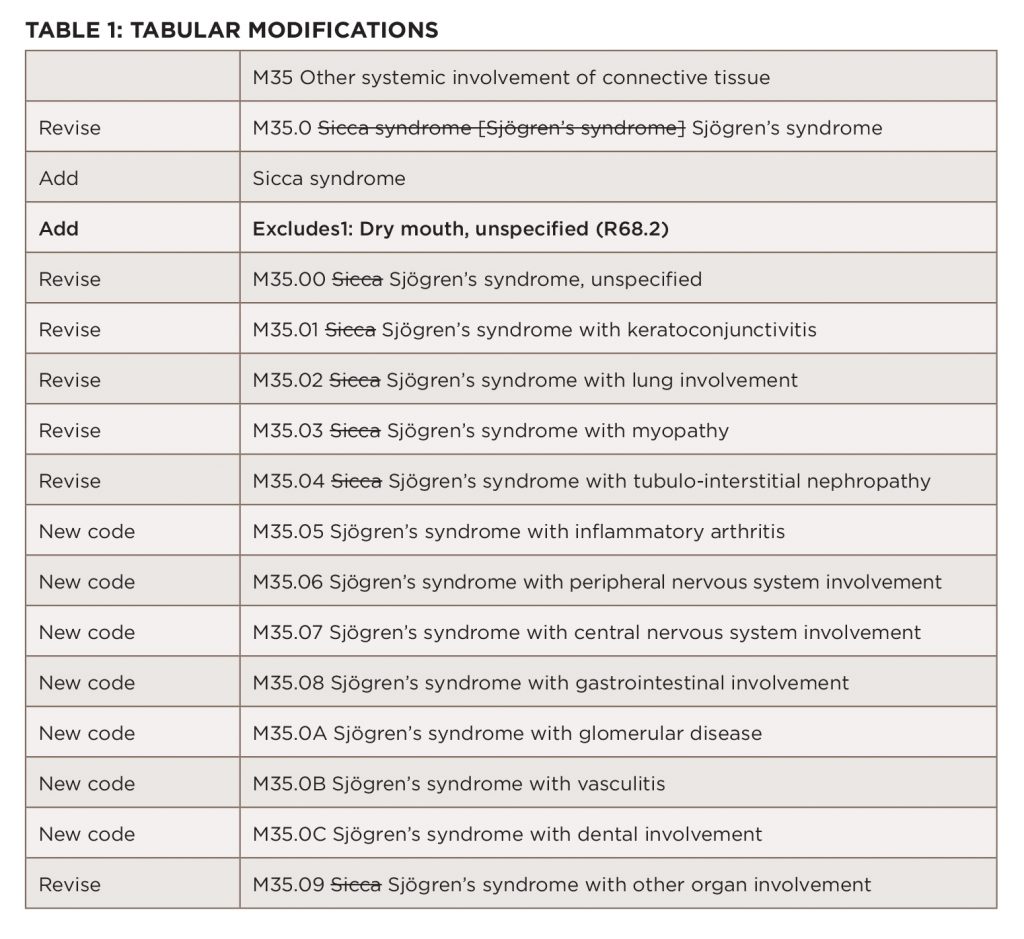Updated Oct. 1, 2020, to include a new implementation date per the CDC.
Oct. 11, 2019: In early 2018, the ACR and the Sjögren’s Syndrome Foundation joined forces to request a code change in the ICD-10 classification for Sjögren’s syndrome, the second most common autoimmune rheumatic disease. An advisory team, comprising specialists in rheumatology, as well as representatives from eight additional specialties involved in managing Sjögren’s syndrome patients, was assembled. The team helped craft the proposal presented to the ICD-10 Coordination and Maintenance (C&M) Committee during its September 2018 meeting at the Department of Health and Human Services (HHS) Centers for Medicare & Medicaid Services (CMS) office in Baltimore and again in March 2019. Public comment periods followed each presentation, and in July 2019, the C&M committee approved the Sjögren’s syndrome diagnosis code change request, which becomes effective October 2020.
Oct. 1, 2020, Editor’s Note—Due to a re-titling concern and recommendation received during the public comment period, CDC has delayed implementation of the new code until October 2021. See sidebar for more information.
The Need to Update Sjögren’s Syndrome Coding
The groundwork to revise the Sjögren’s syndrome diagnosis code was started specifically to separate it from the tabular listing of M35.0 in the ICD-10 coding manual, which is linked to sicca syndrome. The advisory team (see list below) determined the current ICD-10 code is inaccurate and doesn’t contribute to the highest level of specificity of coding for Sjögren’s syndrome. The existing code, M35.0, sicca syndrome [Sjögren], is misleading, because sicca syndrome, in current parlance, refers to the symptom complex of dry eyes and dry mouth without consideration of etiology. There are many potential causes of sicca syndrome, including side effects of commonly used medications and inflammatory diseases of the saliva and tear-producing glands. In the past, sicca syndrome was used synonymously with Sjögren’s syndrome, but now, with a better understanding of Sjögren’s syndrome, we know they are distinct terms and should not be used interchangeably.
Sjögren’s syndrome is a systemic autoimmune disease that affects the entire body. In Sjögren’s syndrome, the immune system targets the mucous membranes and moisture secreting glands, leading to decreased moisture throughout the body and resulting in decreased tears and saliva, dry skin, dry vagina and decreased moisture in the esophagus, lungs and digestive tract. Along with symptoms of extensive dryness, other serious complications include profound fatigue, chronic pain, major organ involvement, neuropathies and lymphomas.
With the implementation of this revised tabular modification for Sjögren’s syndrome, it is important to review the code changes and begin educating coders, clinical documentation professionals and providers about the changes. Missing pieces are the designations for the final complications and comorbidities, and major comorbidities, which will be published with the Inpatient Prospective Payment System (IPPS) Final Rule for fiscal year 2020 (see Table 1).

Who Makes Updates to ICD-10 Codes?
The ICD-10 C&M Committee is a federal interdepartmental committee comprising representatives from the CMS and the Centers for Disease Control & Prevention’s National Center for Health Statistics. The committee is responsible for approving coding changes, developing errata, addenda and other modifications. Requests for coding changes are submitted to the committee for discussion at either their spring or fall C&M meeting. The meetings are a public forum for the presentation of proposed modifications to the International Classification of Diseases, 10th Revision, Clinical Modification and ICD-10 Procedure Coding System.
The Sjögren’s Syndrome Code Change Advisory Team

Members of the Sjögren’s syndrome team: Alan Baer, MD, Antanya Chung, Kathy Hammitt, Steven Taylor, Matt Makara
The ICD-10 code change advisory team consisted of an excellent representation from different fields and stakeholders who volunteered their time and expertise and worked tirelessly to accomplish the code changes. Special thanks to Alan Baer, MD, who graciously accepted the role of representing the team at the ICD-10 C&M meeting, and to all the stakeholders who provided excellent input.
The Sjögren’s syndrome team included:
- ACR/CORC: Antanya Chung
- Sjögren’s Syndrome Foundation: Steven Taylor and Kathy Hammitt
- Industry: Jo Annah Jensen (Novartis)
- Presenter: Alan N. Baer, MD (Director, Jerome Greene Sjögren’s Syndrome Clinic & professor of medicine, Johns Hopkins University School of Medicine, Baltimore)
- Additional Rheumatologists: Nancy Carteron, MD (University of California, San Francisco); Theresa Lawrence Ford, MD (Sjögren’s Syndrome Foundation Medical & Scientific Advisory Board chair; CEO & medical director, North Georgia Rheumatology Group, Lawrenceville, Ga.); Frederick Vivino, MD (director, Sjögren’s Syndrome Center, Perelman School of Medicine at the University of Pennsylvania, Philadelphia)
- Pediatric Rheumatology: Scott Lieberman, MD (University of Iowa Carver College of Medicine, Iowa City)
- PCP: Judith Furlong, MD (ProMedica Physicians Family Medicine, Toledo, Ohio; Sjögren’s patient)
- Rheumatology & Neurology: Julius Birnbaum, MD (co-director, Jerome Greene Sjögren’s Syndrome Clinic, Johns Hopkins University School of Medicine, Baltimore)
- Pulmonary: Augustine Lee, MD (Mayo Clinic, Jacksonville, Fla.)
- Renal: Marie Hogan, MD (Mayo Clinic, Rochester, Minn.)
- Ophthalmology: Lance Forstot, MD (Corneal Consultants of Colorado, Littleton)
- Oral medicine: Vidya Sankar, MD (Brigham and Women’s Hospital, Boston)
- Oncology: Richard Ambinder, MD, PhD (Johns Hopkins University School of Medicine, Baltimore)
- GI: Katerina Shetler, MD (Palo Alto Medical Foundation, Mountain View, Calif.)
The ACR and Sjögren’s Syndrome Foundation are excited that this key update will bring more specificity to Sjögren’s diagnosis coding. For coding questions and tabular modifications on the ICD-10 update, contact Antanya Chung at [email protected] or [email protected].
CDC Delays Implementation of New Sjögren’s ICD-10 Code until 2021
added Oct. 1, 2020
Due to a re-title concern and recommendation received during the ICD-10 public comment period, the scheduled release for the revised Sjögren’s diagnosis code has been pushed back to FY22 (Oct. 1, 2021). The ICD-10 Coordination & Maintenance committee stated, “We were able to resolve some of the issues internally without a representation at the March 2020 ICD-10-CM Coordination and Maintenance meeting, but could not meet the timeline for the Oct. 1, 2020, release, so unfortunately the implementation date was delayed. We apologize for any inconvenience.”
The ACR appreciates the effort and support through this process and looks forward to working with the CDC to address any future comments. For all related questions on diagnosis coding for Sjögren’s or any additional information, contact the ACR’s coding and practice department at [email protected].

